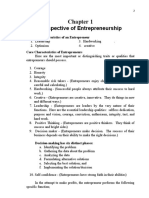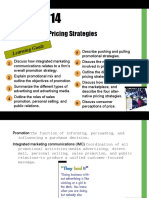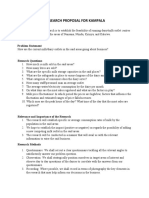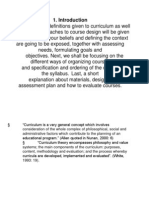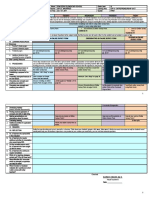0 ratings0% found this document useful (0 votes)
128 viewsSudan International University: Starting A New Venture and The Business Idea
Sudan International University: Starting A New Venture and The Business Idea
Uploaded by
mohammed fwziThis document discusses starting a new business venture and generating business ideas. It provides various techniques for generating ideas, such as brainstorming, focus groups, observation, surveys, emerging trends research, and trade shows. The document also outlines the product planning and development process, including the idea, concept, development, and test marketing stages. Overall, the key topics covered are sources of business ideas, methods for generating ideas, and the process of planning and developing new product or service offerings.
Copyright:
© All Rights Reserved
Available Formats
Download as PPTX, PDF, TXT or read online from Scribd
Sudan International University: Starting A New Venture and The Business Idea
Sudan International University: Starting A New Venture and The Business Idea
Uploaded by
mohammed fwzi0 ratings0% found this document useful (0 votes)
128 views41 pagesThis document discusses starting a new business venture and generating business ideas. It provides various techniques for generating ideas, such as brainstorming, focus groups, observation, surveys, emerging trends research, and trade shows. The document also outlines the product planning and development process, including the idea, concept, development, and test marketing stages. Overall, the key topics covered are sources of business ideas, methods for generating ideas, and the process of planning and developing new product or service offerings.
Original Title
lec 3 business idea
Copyright
© © All Rights Reserved
Available Formats
PPTX, PDF, TXT or read online from Scribd
Share this document
Did you find this document useful?
Is this content inappropriate?
This document discusses starting a new business venture and generating business ideas. It provides various techniques for generating ideas, such as brainstorming, focus groups, observation, surveys, emerging trends research, and trade shows. The document also outlines the product planning and development process, including the idea, concept, development, and test marketing stages. Overall, the key topics covered are sources of business ideas, methods for generating ideas, and the process of planning and developing new product or service offerings.
Copyright:
© All Rights Reserved
Available Formats
Download as PPTX, PDF, TXT or read online from Scribd
Download as pptx, pdf, or txt
0 ratings0% found this document useful (0 votes)
128 views41 pagesSudan International University: Starting A New Venture and The Business Idea
Sudan International University: Starting A New Venture and The Business Idea
Uploaded by
mohammed fwziThis document discusses starting a new business venture and generating business ideas. It provides various techniques for generating ideas, such as brainstorming, focus groups, observation, surveys, emerging trends research, and trade shows. The document also outlines the product planning and development process, including the idea, concept, development, and test marketing stages. Overall, the key topics covered are sources of business ideas, methods for generating ideas, and the process of planning and developing new product or service offerings.
Copyright:
© All Rights Reserved
Available Formats
Download as PPTX, PDF, TXT or read online from Scribd
Download as pptx, pdf, or txt
You are on page 1of 41
Sudan International University
Faculty of Management Sciences
high diploma in Business Administration
Entrepreneurship Development
Starting a New Venture and
the Business Idea
Offered by :Dr. Ashraf Elsiddig Babikier
Learning Objectives
1- To identify various sources of ideas for new venture
2-To know the methods available for generating new venture
ideas
3- To discuss creativity and the techniques for creative problem
solving
4-To discuss the aspects of the product planning and
development process
5- To discuss aspects of e-commerce and starting an e-
commerce business
INTRODUCTION
Entrepreneurs need ideas to start and grow their
entrepreneurial ventures.
Sometimes, the most difficult aspect of starting a business
is coming up with a business idea.
Even if you have a general business idea in mind, it usually
needs to go through fine-tuning processes.
The best ideas for a new business are likely to come from
activities and people that you already know well.
Finding a good idea is the first step in the
process of converting an entrepreneurs creativity
into an opportunity.
Business Idea
Any good business ideas could be an invention,
a new product or service, or an idea or solution
to an everyday problems.
A good business idea does not necessarily have
to be a unique products or services.
Majority of the entrepreneurs recognized their
accomplishment to the exceptional execution of
ordinary ideas.
The chances of success therefore will be far
greater if you can market a product that is
similar to existing offerings, while providing
greater value to customers.
Ways to build upon the already existing material
and would still provide a profit-driven concept:
(a) Develop ideas as an extension of an existing
product (i.e. adding camera and song features to a
mobile phone).
(b) Create an improved service (fast delivery
services).
(c) Market a product at a lower price (via e-
commerce e.g. amazon.com).
(d) Add value to an existing product or service
(i.e. reputable brand name or delivery service).
(e) Altering their quality or quantity.
(f) Introducing automation, simplification,
convenience .
(g) Personal interests or hobbies - many people
find ways to turn their hobbies into successful
businesses.
(h) Work experiences, skills, abilities -a business,
related to the work you do.
(i) A familiar or unfamiliar) Antiques ,pets) product
or service.
(j) Spot the latest trends. Trends that will provide
opportunities include: green trend, clean-energy
trend, organic-orientation trend, economic trend,
social trend, health trend, and Web trend. See CHAPTER 4
CREATIVITY AND THE BUSINESS IDEA 87
(k) Changing the delivery method, packaging,
unit size or shape.
(l) Increasing mobility, access, portability or
disposability.
(m) Simplifying repair, maintenance,
replacement or cleaning.
(n) Changing their colour, material or shape.
A survey of entrepreneurs found that most
new start-up companies are involved
in industries where they had significant work
experience.
The personal contacts and domain(expertise )
developed on the job have proven to be
valuable to many individuals who planned
launching a business of their own.
Anybody who intends to start a business in
a new industry are therefore encouraged to
firstly become a "learner" for a suitable
period of time.
By doing that, you could avoid costly
mistakes and at the same time be able to
assess whether you enjoy the work before
making a serious financial commitment.
SOURCES OF NEW IDEAS
Some of the more frequently used sources
of ideas for new entrepreneur include
consumers, existing companies,
distribution channels, the government and
research and development
METHODS OF GENERATING NEW IDEAS
Even with the wide variety of sources
available, coming up with an idea to
serve as the basis for the new venture
can still be a difficult problem.
The entrepreneur can use several
methods to help generate and test new
ideas.
TECHNIQUES FOR GENERATING IDEAS
Brainstorming
This is a process in which a small group of people interact with
very little structure, with the goal of producing a large quantity
of novel and imaginative ideas.
The goal is to create an open, uninhibited atmosphere
that allows members of the group to „freewheel- sail- ideas.
Normally, the leader of the group asks the participants to share
their ideas.
As group members interact, each idea stimulate the thinking of
others, and the producing of ideas becomes contagious.
Focus Groups
These are group of individuals who provide
information using a structured format.
Normally, a moderator will lead a group of
people through an open, in depth discussion.
The group members will form comments in
open-end in-depth discussion for a new
product area that can result in market
penetration.
Observation
A method to describe peoples behaviour by probing:
(i) What do people/organisations buy?
(ii) What do they want and cannot buy?
(iii) What do they buy and don't like?
(iv) Where do they buy, when and how?
(v) Why do they buy?(vi) What they buying more of?
(vii) What else might they need but cannot get?
Surveys
This process involves the gathering of data based
on communication with a representative sample of
individuals.
This research technique requires asking people
who are called respondents for information either
verbally or by using written questions.
Questionnaires or interviews are utilized to collect
data on the telephone or face-to-face interview.
Emerging Trends is based on the population within
your area may be getting older and creating
demand for new products and services.
(f) Research and Development is a planned
activity aimed at discovering new knowledge, with
the hope of developing new or improved products
and services. Researching new methods, skills and
techniques enable entrepreneurs to enhance their
performance and ability to deliver better products
and services.
(g) Tradeshows and association meetings
This can be an excellent way to examine the
products of many potential
competitors, uncover product trends and identify
potential products.
h) Other Technique can be achieved by reading
relevant trade magazines and browsing
through trade directories. These may include local,
national and foreign publications.
Techniques for creative problem solving
While creativity is an important attribute of a
successful entrepreneur, unfortunately,
Creativity tends to decline with age, education,
lack of use, and bureaucracy.
Creativity can be unlocked. Creative ideas and
innovations generated by using any of the creative
problem-solving techniques as follows:
Brainstorming
The first technique, brainstorming, is probably the most
well known and widely used for both creative problem
solving and idea generation.
It is an unstructured process for generating all possible
ideas about a problem within a limited time frame through
the spontaneous contribution of participants.
All ideas, no matter how illogical, must be recorded, with
participants prohibited from criticizing or evaluating during
the brainstorming session.
Brainwriting
Brainwriting is a form of written
brainstorming. Brainwriting is a silent, written
generation of ideas by a group of people.
The participants write their ideas on
special forms or cards that circulate within the
group, which usually consists of six members.
Each group member generates and writes
down three ideas during a five-minute period.
The form is passed on to the adjacent person
who writes down three new ideas, and so on,
until each form has passed all participants.
A leader monitors the time intervals and can
reduce or lengthen the time given to participants
according to the needs of the group. Participants
can also be spread geographically with the sheets
rotated electronically.
Reverse brainstorming
Similar to brainstorming, but criticism is allowed and encouraged as
a way to bring out possible problems
with the ideas.
Synectics
Synectics is a creative process that forces individuals to solve
problems through one of four analogy
mechanisms: personal, direct, symbolic and fantasy.
This forces participants to consciously apply preconscious
mechanisms through the use of analogies in order to solve problems.
.
Gordon method
Gordon method is a method of developing new ideas
when the individuals are unaware of the problem. In
this method the entrepreneur starts by mentioning a
general concept associated with the problem. The
group responds with expressing a number of ideas.
Checklist method
Developing a new idea through a list of related issues
is checklist method of problem solving.
Product Planning and Development Process
Criteria should be established at each
stage of the product planning and
development process.
Establishing Evaluation Criteria should be
all-inclusive and quantitative in nature.
Criteria should evaluate the idea of product in
terms of:
Market opportunity.
Competition.
Marketing system.
Financial factors.
Production factors.
The Product Planning and Development Process
Stages of Product Planning and Development Process :
Idea Stage
Promising ideas should be identified and impractical ones
eliminated.
Evaluation method – Systematic market evaluation checklist.
Determine the need for the new idea as well as its value to the
company.
Concept Stage
Refined idea is tested to determine consumer acceptance
which can be measured through the conversational interview
method.
Development Stage
Consumer reaction to the product/service is
determined.
A consumer panel is given a product sample
and preference is determined through methods
such as multiple brand comparisons, risk
analysis, etc.
Test Marketing Stage
Increases certainty of successful
commercialization.
Actual sales reflect acceptance of consumers.
Positive test results indicate the degree of
probability of a successful product launch and
company formation.
E-commerce and Business Start-up
E-commerce offers
commercial transactions conducted electronically on the internet
entrepreneurs an opportunity to creation and
innovation.
Factors that facilitate high-growth in electronic
commerce:
1-Widespread use of personal computers and
mobile phones .
2-Adoption of intranets in companies.
3-Acceptance of the Internet as a business
communications platform.
4-Faster and more secure systems.
Using E-Commerce Creatively
Entrepreneurs have to decide whether to:
-Run Internet operations within the company.
-Outsource these operations to Internet
specialists.
-Use e-commerce packages
provided by software companies.
The integration of front-end and
back-end operations represents the
greatest challenge for doing Internet
business.
Web Sites
Ease of use.
Structure and organization of information.
Search capability.
E-mail response system.
Speed.
Compatibility with different browsers and platforms.
Tracking Customer Information
Electronic databases track the activity of
the industry, segment, and company.
It supports personal marketing targeted
at individual clients.
Care must be taken to follow the laws
protecting the privacy of individuals.
Doing E-Commerce as an Entrepreneurial Company
Products should be delivered economically and
conveniently.
Products need to interest a wide market;
company must be ready to ship the product
outside its own geographical location.
Online operations should bring
significant cost reductions.
Company must be able to
economically draw customers to its Web site.
You might also like
- Week 4 - Module 4.2 Creative Problem SolvingDocument22 pagesWeek 4 - Module 4.2 Creative Problem SolvingMichel BanvoNo ratings yet
- Organizing and Delivering A Persuasive SpeechDocument13 pagesOrganizing and Delivering A Persuasive SpeechAngelica Orbizo83% (6)
- Application LetterDocument1 pageApplication LetterRonna Micah Cunanan100% (1)
- Innovation, Invention, and Creativity - Definition, Difference, and Examples - Info 1Document6 pagesInnovation, Invention, and Creativity - Definition, Difference, and Examples - Info 1Muhammad Zarif IshakNo ratings yet
- F1-08 Committees in The Business OrganisationDocument10 pagesF1-08 Committees in The Business Organisationrohansing2rNo ratings yet
- Does Consumer Buying Behavior Change During Economic Crisis?Document16 pagesDoes Consumer Buying Behavior Change During Economic Crisis?nazimNo ratings yet
- Advantages and Disadvantages of Committee OrganizationDocument2 pagesAdvantages and Disadvantages of Committee OrganizationEJENAKE JOHNNo ratings yet
- Module 2 Innovation As A Core Business ProcessDocument33 pagesModule 2 Innovation As A Core Business ProcessBruno SaturnNo ratings yet
- 5-0 - Creativity & InnovationDocument17 pages5-0 - Creativity & InnovationZameer AbbasiNo ratings yet
- Introduction To Property Rights Unit-1Document41 pagesIntroduction To Property Rights Unit-1Sai Gopal BonthuNo ratings yet
- Business Ethics, Stakeholder ManagementDocument17 pagesBusiness Ethics, Stakeholder ManagementRempeyekNo ratings yet
- PM 0017-Project Quality ManagementDocument10 pagesPM 0017-Project Quality ManagementNick SinNo ratings yet
- Demand and Cost Determinants of PriceDocument22 pagesDemand and Cost Determinants of PriceRadHika GaNdotraNo ratings yet
- American College of Technology: Marketing Research and IntelligenceDocument40 pagesAmerican College of Technology: Marketing Research and IntelligenceTekta MideksaNo ratings yet
- Business EthicsDocument3 pagesBusiness EthicsAshika JayaweeraNo ratings yet
- The 5 Stages in The Design Thinking ProcessDocument5 pagesThe 5 Stages in The Design Thinking Processhervehirwa25No ratings yet
- Chapter 04Document44 pagesChapter 04hassan10012No ratings yet
- Sources of InnovationDocument22 pagesSources of Innovationm umair zahirNo ratings yet
- Promotion Mix: Mahesh P IPEDocument11 pagesPromotion Mix: Mahesh P IPEDavid100% (1)
- Elevator Pitch NotesDocument10 pagesElevator Pitch NotesCJNo ratings yet
- Feasibility Analysis For Social Ventures: Beugré CDocument45 pagesFeasibility Analysis For Social Ventures: Beugré CBoyagNo ratings yet
- Green MarketingDocument17 pagesGreen MarketingAnonymous F6fyRYGOqG100% (1)
- CommitteesDocument20 pagesCommitteesBassam AlqadasiNo ratings yet
- Chapter 17 - Digital and Social Media MarketingDocument29 pagesChapter 17 - Digital and Social Media MarketingMarwa HassanNo ratings yet
- International Human Resource ManagementDocument36 pagesInternational Human Resource ManagementManmeet KaurNo ratings yet
- HRM Chapter1Document16 pagesHRM Chapter1Haseeb AhmadNo ratings yet
- Unit 1 Innovation & Entrepreneurship KMBN302Document30 pagesUnit 1 Innovation & Entrepreneurship KMBN302khushi GuptaNo ratings yet
- Me801 Entrepreneurship Development SyllabusDocument1 pageMe801 Entrepreneurship Development SyllabusRichard S DavidsonNo ratings yet
- Product Management Lecture 1Document44 pagesProduct Management Lecture 1Saad KhanNo ratings yet
- Basic Economic ConceptsDocument62 pagesBasic Economic ConceptsMarkus Bernabe DaviraNo ratings yet
- 4: Managing Marketing Information To Gain Customer InsightsDocument12 pages4: Managing Marketing Information To Gain Customer InsightsSalman HaiderNo ratings yet
- Ic Lo1Document24 pagesIc Lo1Zilen Salam100% (1)
- The Influence of Culture Subculture On Consumer BehaviorDocument56 pagesThe Influence of Culture Subculture On Consumer BehaviorHajra ArifNo ratings yet
- Chapter 1 - Introduction To EntrepreneurshipDocument13 pagesChapter 1 - Introduction To EntrepreneurshipJana Arvin50% (2)
- Social Responsibility of BusinessDocument15 pagesSocial Responsibility of BusinessCommercioNo ratings yet
- Theories of Entrepreneurship and Entrepreneurial MotivationDocument39 pagesTheories of Entrepreneurship and Entrepreneurial MotivationLIBIN JOSENo ratings yet
- Cae Study11Document9 pagesCae Study11Srivatsav SriNo ratings yet
- Entrepreneurship 1Document24 pagesEntrepreneurship 1Niks HereNo ratings yet
- Chapter 1Document20 pagesChapter 1shihan100% (1)
- Consumer Research ProcessDocument78 pagesConsumer Research ProcessShikha PrasadNo ratings yet
- Chapter 4Document29 pagesChapter 4bibukar jung karkiNo ratings yet
- Entrepreneurship Ch.2Document27 pagesEntrepreneurship Ch.2Joseph KinfeNo ratings yet
- Marks Instructions: Case Let No. 1 Looking For CapitalDocument3 pagesMarks Instructions: Case Let No. 1 Looking For CapitalShahanshah AlamNo ratings yet
- Theories of Retail DevelopmentDocument10 pagesTheories of Retail DevelopmentBen MathewsNo ratings yet
- Promotion and Pricing Strategies: Learn Ing G OalsDocument42 pagesPromotion and Pricing Strategies: Learn Ing G OalsCristine SaludoNo ratings yet
- Legal and IP Issues in EntrepreneurshipDocument27 pagesLegal and IP Issues in EntrepreneurshipPaeng PadrinoNo ratings yet
- Ent530-Case Study-Guidelines & TemplateDocument5 pagesEnt530-Case Study-Guidelines & TemplateAdlina HazwaniNo ratings yet
- GROUP ASSIGNMENT Managerial EconomicsDocument26 pagesGROUP ASSIGNMENT Managerial Economicsmahedre100% (1)
- Chapter 5 The Business PlanDocument21 pagesChapter 5 The Business PlanEileen Enriquez100% (1)
- College of Agriculture and ForestryDocument17 pagesCollege of Agriculture and ForestryJoann JacobNo ratings yet
- CH 5 Creativity and The Business IdeaDocument32 pagesCH 5 Creativity and The Business IdeaAsif NawazNo ratings yet
- Enterpreneurship and Small Business DevelopmentDocument17 pagesEnterpreneurship and Small Business DevelopmentBasil AugustineNo ratings yet
- Session 21 Pricing DecisionsDocument18 pagesSession 21 Pricing DecisionsNarayana ReddyNo ratings yet
- Principles of Marketing 2Document52 pagesPrinciples of Marketing 2Anonymous zZ6uRo100% (1)
- University of The GambiaDocument53 pagesUniversity of The GambiasoninkeNo ratings yet
- Export Processing Zone PDFDocument2 pagesExport Processing Zone PDFStacyNo ratings yet
- Generation, Incubation and Commercialization of Ideas and InnovationsDocument7 pagesGeneration, Incubation and Commercialization of Ideas and InnovationsFuzail RasheedNo ratings yet
- Entrepreneurial Mindset Culture and Leadership PDFDocument58 pagesEntrepreneurial Mindset Culture and Leadership PDFSumit KohliNo ratings yet
- Unit VI Socio-Cultural Influences On Consumer BehaviorDocument52 pagesUnit VI Socio-Cultural Influences On Consumer BehaviorVivek Lal Karna100% (1)
- Dairy Business Research Proposal For KampalaDocument2 pagesDairy Business Research Proposal For KampalaSteven Nuwagira0% (1)
- Assignments - MB0046 - Marketing ManagementDocument2 pagesAssignments - MB0046 - Marketing ManagementMehdi Hasan100% (1)
- Technology Integration in Higher Education Social and Organizational Aspects Premier Reference Source 1st Edition Daniel W. SurryDocument84 pagesTechnology Integration in Higher Education Social and Organizational Aspects Premier Reference Source 1st Edition Daniel W. Surrymjalirygol100% (2)
- Spahiu 2021 IOP Conf. Ser. Mater. Sci. Eng. 1031 012039Document10 pagesSpahiu 2021 IOP Conf. Ser. Mater. Sci. Eng. 1031 012039aqsa imranNo ratings yet
- Artifical Intelligence Class 10thDocument193 pagesArtifical Intelligence Class 10thrajbirsinghgill002No ratings yet
- Syllabus Design Lecture 1Document34 pagesSyllabus Design Lecture 1Mohammed Abdul HaiNo ratings yet
- 研究论文作业指导Document11 pages研究论文作业指导afefihceaNo ratings yet
- Arts 7 M5Document27 pagesArts 7 M5Dianne Abante100% (2)
- PSP Series: (Preparation For Summer Placements)Document10 pagesPSP Series: (Preparation For Summer Placements)priyam dixit100% (1)
- 1988 Mahatma Gandhi Humanitarian Award Ceremony HandbillDocument12 pages1988 Mahatma Gandhi Humanitarian Award Ceremony HandbillJerome Garcia100% (1)
- APAMSA IM Bootcamp Slides 2023Document101 pagesAPAMSA IM Bootcamp Slides 2023froma happyNo ratings yet
- Applying Neuroscience To ArchitectureDocument4 pagesApplying Neuroscience To ArchitectureLila Feiber BabiukNo ratings yet
- Pa-3 Literature Rev WKST PDFDocument2 pagesPa-3 Literature Rev WKST PDFAishah GojeNo ratings yet
- Yield Line Analysis For Slabs: Version 2 CE IIT, KharagpurDocument31 pagesYield Line Analysis For Slabs: Version 2 CE IIT, KharagpurkvrgmsNo ratings yet
- Result and Discussion of Result (ANguyen - Xuan Khang)Document4 pagesResult and Discussion of Result (ANguyen - Xuan Khang)Nguyên VươngNo ratings yet
- Nursing Leadership and Management 2Document8 pagesNursing Leadership and Management 2Maybelyn JoradoNo ratings yet
- Module 1 Metacognition PasunodDocument16 pagesModule 1 Metacognition PasunodKylaMayAndrade71% (7)
- Al Farah Izzatie Al Buhari (Resume)Document7 pagesAl Farah Izzatie Al Buhari (Resume)Khairul IshakNo ratings yet
- RIA Litrature Review AKASH 200Document3 pagesRIA Litrature Review AKASH 200Just CoolNo ratings yet
- DLL Epp6-Ict Q1 W5Document2 pagesDLL Epp6-Ict Q1 W5MADELIN ORTEGANo ratings yet
- Instrucciones Intervention ProposalDocument20 pagesInstrucciones Intervention ProposalEliana GomezNo ratings yet
- Baby DumpingDocument3 pagesBaby DumpingKISSANRAJNo ratings yet
- Ipic 2018Document4 pagesIpic 2018Afwin ZamronyNo ratings yet
- DISS Syllabus 1920 4TH QUARTERDocument8 pagesDISS Syllabus 1920 4TH QUARTERangie vibarNo ratings yet
- Arthur Pet Business SSDocument6 pagesArthur Pet Business SSShameran HirmisNo ratings yet
- TLE6 - Q1 - Mod8 - Conduct Survey On Animal and Fish Raising - Version3Document43 pagesTLE6 - Q1 - Mod8 - Conduct Survey On Animal and Fish Raising - Version3LYNN MADDAWATNo ratings yet
- Cyril Potter College CompletedDocument9 pagesCyril Potter College CompletedTravon CharlesNo ratings yet
- RO6 Math GamesDocument7 pagesRO6 Math GamesJeanrose Pagunsan FloresNo ratings yet
- Cinematheque CentreDocument11 pagesCinematheque CentremarcheinNo ratings yet
- Professional Behaviors 2021Document3 pagesProfessional Behaviors 2021api-511962078No ratings yet






































